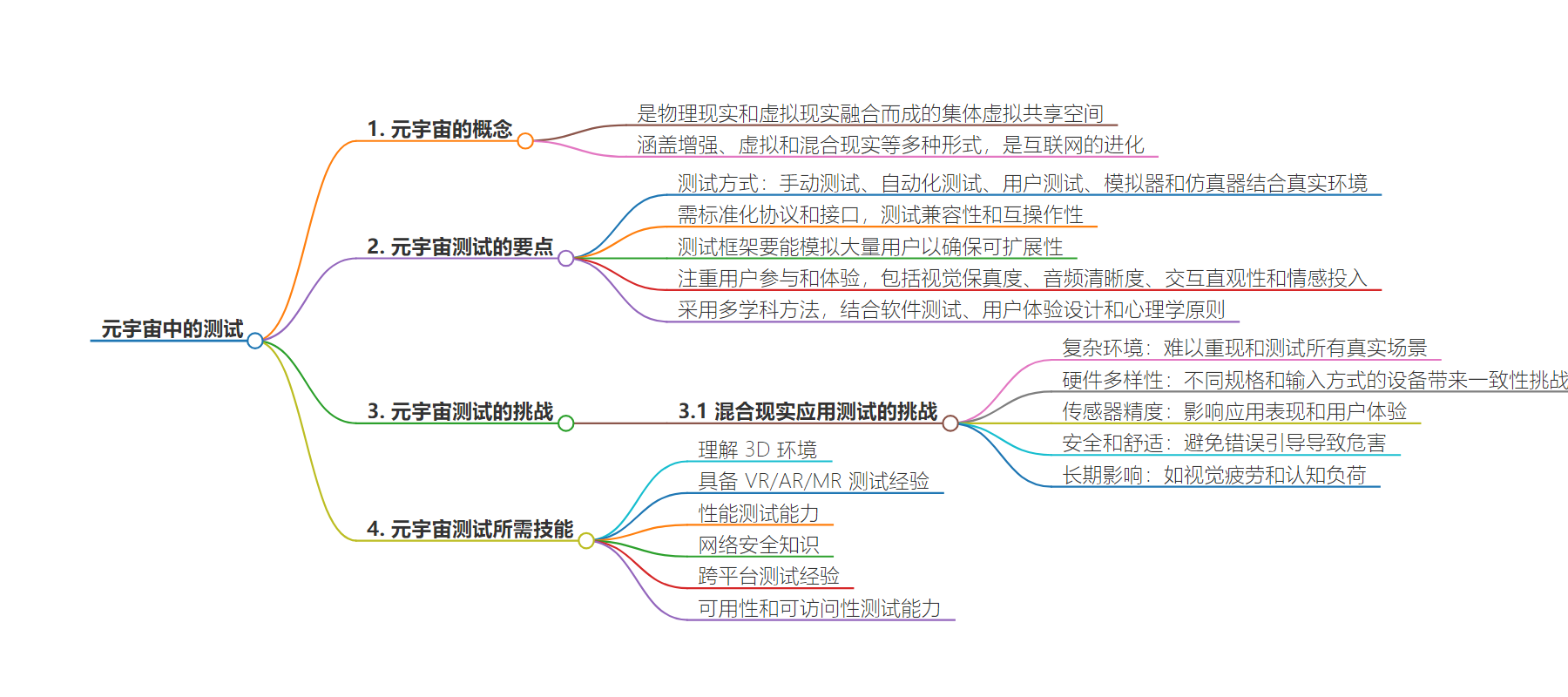包阅导读总结
1.
关键词:Metaverse、Testing、Virtual Reality、User Experience、Skills
2.
总结:本文主要介绍了元宇宙中的测试,包括所需的测试方式组合、面临的挑战和所需技能。元宇宙涵盖多种现实,测试需考虑兼容性等,还需模拟大量用户,注重用户体验,测试人员需具备多种技术和软技能。
3.
主要内容:
– 元宇宙介绍
– 是虚拟增强物理现实和持续虚拟现实融合的集体虚拟共享空间。
– 不止单一在线世界,包括增强、虚拟和混合现实等。
– 元宇宙中的测试
– 测试方式:手动测试、自动化测试、用户测试等结合。
– 面临挑战:环境复杂、硬件多样、传感器精度、安全舒适、长期影响。
– 所需技能:了解 3D 环境、有 VR/AR/MR 测试经验、性能测试能力、网络安全知识、跨平台测试经验、可用性和可访问性测试能力。
– 相关活动
– 乔纳森·赖特在 Testing United 做关于元宇宙测试的演讲。
– InfoQ 对乔纳森·赖特进行元宇宙测试的采访。
思维导图:
文章来源:infoq.com
作者:Ben Linders
发布时间:2024/7/18 0:00
语言:英文
总字数:768字
预计阅读时间:4分钟
评分:88分
标签:元宇宙,测试,虚拟现实,增强现实,混合现实
以下为原文内容
本内容来源于用户推荐转载,旨在分享知识与观点,如有侵权请联系删除 联系邮箱 media@ilingban.com
The “metaverse” typically refers to a collective virtual shared space that is created by the convergence of a virtually enhanced physical reality and a persistent virtual reality. According to Jonathon Wright, testing requires a mix of manual testing, automated testing, user testing, emulators, and simulators. Real-world testing environments are used in combination to cover as many scenarios as possible.
Jonathon Wright gave a talk about testing in the metaverse at Testing United.
The metaverse isn’t just a single online world, but rather encompasses the entire spectrum of augmented, virtual, and mixed realities, Wright explained:
The metaverse can be thought of as the “universe of digital twins” or a sum of all virtual worlds, augmented reality, and the internet. It’s the next evolutionary step of the internet, offering more immersive and interactive environments.
Wright stated that the metaverse envisions a seamlessly interconnected digital universe where users can move across different virtual environments without friction. This requires standardised protocols and interfaces, making testing for compatibility and interoperability between various systems and platforms a necessity, he said. Ensuring seamless transitions and consistent user experiences across different metaverse environments poses a complex task for testers.
The metaverse is designed to support a massive number of concurrent users interacting with complex, data-intensive environments. Wright mentioned that this requires testing frameworks that can simulate thousands, if not millions, of users to ensure the metaverse can scale without compromising performance or user experience.
User engagement and experience are at the heart of the metaverse, emphasising the need for testing to go beyond functionality and performance, Wright said. Testing must encompass the quality of the immersive experience, including visual fidelity, audio clarity, interaction intuitiveness, and emotional engagement, as Wright explained:
Testing involves a multidisciplinary approach, combining software testing with user experience design and psychological principles to evaluate and enhance the immersive qualities of the metaverse.
For anyone looking to get involved in metaverse testing, it’s a blend of building on existing testing knowledge, diving deep into emerging technologies, and continually staying updated as the metaverse landscape evolves, Wright concluded.
InfoQ interviewed Jonathon Wright about testing in the metaverse.
InfoQ: What are the challenges of testing mixed reality?
Jonathon Wright: Some of the primary challenges involved in testing mixed reality applications are:
- Complex Environments: MR experiences are designed to adapt to the physical environment they are deployed in. This can make it difficult to recreate and test all possible real-world scenarios, as conditions like lighting, spatial arrangements, and even the presence of various objects can change the behaviour of the application.
- Hardware Diversity: the variety of MR devices, with different specifications, input methods (like gestures, voice commands, etc.), and sensors introduce challenges in ensuring consistent application behaviour across all of them.
- Sensor Accuracy: mixed reality applications often rely on sensors (e.g., cameras, accelerometers, gyroscopes) to interpret the physical world. Ensuring that these sensors work accurately and consistently is crucial. For instance, tracking accuracy can profoundly impact the user experience.
- Safety and Comfort: MR applications can cause discomfort or even harm if they misinterpret the physical space (e.g., guiding a user into a physical obstacle). Ensuring safety in real-world scenarios is crucial.
- Long-term Effects: understanding the long-term effects (like visual fatigue or cognitive load) of using MR applications is essential. This might not be evident in short-term testing sessions.
InfoQ: What skills are needed for testing in the metaverse?
Wright: Testing in the metaverse brings forth unique challenges due to its immersive, interconnected, and real-time nature. As the metaverse encompasses a vast range of technologies including virtual reality, augmented reality, mixed reality, and more, testers need a blend of technical, domain-specific, and soft skills.
Here are some essential skills for testing in the metaverse:
- Understanding of 3D Environments: a familiarity with 3D modelling, spatial computing, and the mechanics of virtual environments is essential for testing within the metaverse.
- VR/AR/MR Testing Experience: knowledge of tools and techniques for testing virtual, augmented, and mixed reality applications. This includes understanding tracking accuracy, field of view issues, and interaction techniques.
- Performance Testing: the metaverse requires real-time interaction. Testers need to be skilled in assessing latency, load times, and other performance metrics in complex 3D environments.
- Cybersecurity Knowledge: with the increased risks associated with digital avatars, assets, and transactions within the metaverse, a good understanding of security testing principles is vital.
- Cross-platform Testing: the metaverse will be accessed from various devices, from VR headsets to mobile phones. Experience in ensuring consistent experiences across platforms is critical.
- Usability and Accessibility Testing: ensuring intuitive and inclusive user experiences in the metaverse environments. This might involve testing gesture controls, voice commands, and navigation within virtual spaces.
